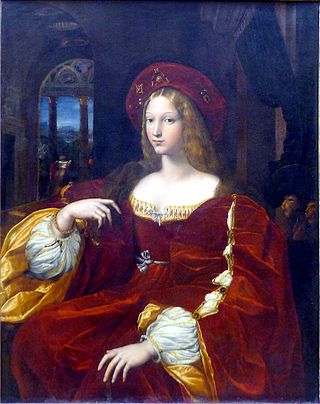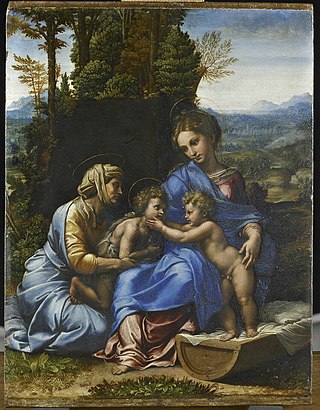
Fra Bartolomeo or Bartolommeo, also known as Bartolommeo di Pagholo, Bartolommeo di San Marco, Paolo di Jacopo del Fattorino, and his original nickname Baccio della Porta, was an Italian Renaissance painter of religious subjects. He spent all his career in Florence until his mid-forties, when he travelled to work in various cities, as far south as Rome. He trained with Cosimo Rosselli and in the 1490s fell under the influence of Savonarola, which led him to become a Dominican friar in 1500, renouncing painting for several years. Typically his paintings are of static groups of figures in subjects such as the Virgin and Child with Saints.

The Palazzo Pitti, in English sometimes called the Pitti Palace, is a vast, mainly Renaissance, palace in Florence, Italy. It is situated on the south side of the River Arno, a short distance from the Ponte Vecchio. The core of the present palazzo dates from 1458 and was originally the town residence of Luca Pitti, an ambitious Florentine banker.

Piazza della Signoria is a w-shaped square in front of the Palazzo Vecchio in Florence, Italy. It was named after the Palazzo della Signoria, also called Palazzo Vecchio. It is the main point of the origin and history of the Florentine Republic and still maintains its reputation as the political focus of the city. It is the meeting place of Florentines as well as the numerous tourists, located near Palazzo Vecchio and Piazza del Duomo and gateway to Uffizi Gallery.

The Self-Portrait with a Friend is a painting by Italian High Renaissance painter Raphael. It dates to 1518–1520, and is in the Louvre Museum of Paris, France. Whether the figure on the left is actually a self-portrait by Raphael is uncertain, although it was already identified as such in a 16th-century print.
Events from the year 1504 in art.

The Garvagh Madonna is an oil painting by the Italian Renaissance artist Raphael, dating to c. 1509–1510. It depicts the Virgin, the Christ Child and the infant John the Baptist, and is one of many paintings by Raphael with this trio. It is from early in the artist's third, or Roman period, in which distinctive changes are seen from his Umbrian or Florentine period in style and use of colour, with the introduction of more natural subjects and settings.

The Madonna della Seggiola or The Madonna della Sedia is an oil on panel Madonna painting by the High Italian Renaissance artist Raphael, executed c. 1513–1514, and housed at the Palazzo Pitti Collection in Florence, Italy. Although there is documentation on its arrival to its current location, Palazzo Pitti, it is still unknown who commissioned the painting; however, it has been in the Medici family since the 16th century.

The Portrait of Elisabetta Gonzaga is an oil on wood painting attributed to the Italian Renaissance artist Raphael, executed c. 1504–1505, and housed in the Uffizi Gallery, Florence.

La donna gravida is an oil on wood portrait by the Italian High Renaissance artist Raphael. It was painted between 1505 and 1506, during Raphael's stay in Florence, Italy. It is now in the Palazzo Pitti in Florence.

The Holy Family is a 1518 painting of the Holy Family, Saint Elisabeth, an infant John the Baptist and two angels. It is signed by Raphael, but most of the work was delegated to his workshop assistants. It was commissioned by Pope Leo X as a gift to Claude, wife of Francis I of France, hence its name. It is now in the Louvre.

The Portrait of Cardinal Bibbiena is a portrait of Cardinal Bernardo Dovizi da Bibbiena by Raphael, painted around 1516 and now in the Palazzo Pitti in Florence. Its rendering appears more rigid than is usual for Raphael, leading some critics to attribute it to one of his pupils or to feel it is possibly a copy from a lost autograph original.

Andrea del Sarto was an Italian painter from Florence, whose career flourished during the High Renaissance and early Mannerism. He was known as an outstanding fresco decorator, painter of altar-pieces, portraitist, draughtsman, and colorist. Although highly regarded during his lifetime as an artist senza errori, his renown was eclipsed after his death by that of his contemporaries Leonardo da Vinci, Michelangelo, and Raphael.

The Portrait of Pope Leo X with two Cardinals is a painting by the Italian High Renaissance master Raphael, executed c. 1518-1520. It is housed in the Uffizi Gallery of Florence. But currently on exhibition at the Palazzo Pitti.

Portrait of Doña Isabel de Requesens y Enríquez de Cardona-Anglesola is an oil painting dated circa 1518 that was formerly believed to depict Giovanna d'Aragona. It has been variously ascribed to Raphael, Giulio Romano, or the school of Raphael; it is now usually taken to have been executed by Giulio Romano based on a sketch by Raphael and then altered by Raphael. The painting is now in the Louvre Museum in Lens.

Adoration of the Shepherds is the title of a lost drawing by Raphael, described in a letter of 8 September 1508, from Raphael to his friend Francesco Raibolini alias Francesco Francia. This letter's contents were first published in 1678, in Carlo Cesare Malvasia's book Felsina Pittrice. Malvasia gave a full account of the letter, which he claimed to have found among the papers of Count Antonio Lambertini in Bologna. While the existence and contents of the letter are disputed, according to Malvasia it described the delivery of a drawing of the Adoration of the Shepherds to Francesco Francia. This drawing has been considered lost or never to have existed.

The Madonna of the Baldacchino is a c.1506-1508 oil on canvas holy conversation-style painting by Raphael, now in the Galleria Palatina in Florence.

Giacomo Recco was an Italian Baroque painter who specialized in flowers. His brother, Giovanni Battista Recco, was also an artist.

The Small Holy Family is an oil-on-panel painting by Raphael and assistants, now in the Louvre in Paris. Its name distinguishes it from his Great Holy Family, also in the Louvre. It is signed and dated "RAPHAEL VRBINAS S[anti] PINGEBAT MDXVIII" on the hem of the Madonna's garment.

Holy Family under an Oak Tree or Madonna of the Oak Tree is an oil on panel painting by Giulio Romano using a composition or underdrawing by Raphael. It is now in the Prado in Madrid. It is dated to c. 1518 by its stylistic similarities to other works produced by the two artists around that time such as La Perla (Prado). In the background is a valley reminiscent of that of the River Tiber, with a ruin on a hill to the left based on the Basilica of Maxentius or the Baths of Caracalla.

Saint John the Baptist as a Boy is a c. 1518-1519 oil on canvas painting by the studio of Raphael, now in the Uffizi in Florence.



















